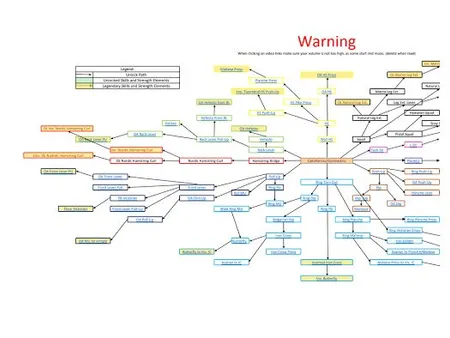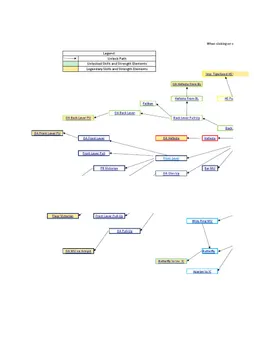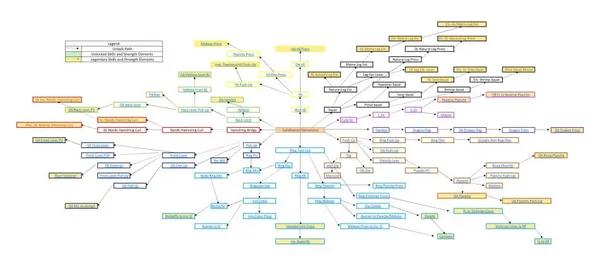Table of Contents
Are you ready to take your calisthenics skills to the next level? Look no further than the calisthenics skill tree at Kizworld. Our comprehensive guide will help you develop a structured training plan that targets specific skills and progressions. Whether you're a beginner just starting out or an experienced athlete looking to refine your technique, the calisthenics skill tree has something for everyone. With detailed exercise descriptions, video demonstrations, and tips, you'll have all the resources you need to unlock your full potential and achieve your fitness goals.
The Ultimate Calisthenics Skill Tree: A Step-by-Step Guide to Calisthenics Progression
Level | Exercises | Benefits |
|---|---|---|
Beginner | Push-ups, squats, lunges | Build strength, endurance, and mobility |
Intermediate | Pull-ups, dips, rows | Increase muscle mass, improve coordination |
Advanced | Muscle-ups, handstands, planche | Master advanced techniques, enhance flexibility |
I. Calisthenics Skill Tree: A Comprehensive Guide to Progression
Mastering the Basics: Building a Solid Foundation
The calisthenics skill tree is a comprehensive guide to help you progress your calisthenics journey. It starts with the basics and gradually introduces more advanced skills. By following the skill tree, you can build a solid foundation and develop the skills you need to achieve your calisthenics goals.The beginner level of the calisthenics skill tree focuses on building strength, endurance, and mobility. This level includes exercises like push-ups, squats, and lunges. These exercises are a great way to get started with calisthenics and build a foundation for more advanced skills.How to Get Started with Calisthenics as a Beginner
Level | Exercises | Benefits |
|---|---|---|
Beginner | Push-ups, squats, lunges | Build strength, endurance, and mobility |
Intermediate Skills: Advancing Your Calisthenics Journey
Once you have mastered the basics, you can progress to the intermediate level of the calisthenics skill tree. This level includes exercises like pull-ups, dips, and rows. These exercises are more challenging than the beginner level exercises, but they will help you increase muscle mass and improve your coordination.How to Do a Pull-Up
- Pull-ups
- Dips
- Rows
Calisthenics Skill Tree: A Comprehensive Guide to Progression
II. Mastering the Basics: Building a Solid Foundation
Laying the Groundwork for Calisthenics Success
Embarking on the calisthenics journey requires a solid foundation, akin to building a sturdy house upon a firm base. This foundation comprises mastering the fundamental movements that will serve as building blocks for more advanced skills. These foundational exercises, such as push-ups, squats, and lunges, are not to be underestimated. They lay the groundwork for strength, endurance, and mobility, essential attributes for any aspiring calisthenics athlete.Push-ups, a cornerstone of calisthenics, engage multiple muscle groups, including the chest, triceps, and shoulders. They can be modified to suit different fitness levels, making them accessible to beginners and seasoned athletes alike. Squats, another fundamental exercise, target the lower body, strengthening the quads, hamstrings, and glutes. They are crucial for building leg strength and stability, essential for advanced calisthenics movements.
Progression and Refinement: The Path to Mastery
As you progress in your calisthenics journey, it's essential to refine your technique and gradually increase the difficulty of your exercises. This can be achieved by incorporating variations and progressions into your routine. For instance, instead of regular push-ups, you can try incline push-ups or decline push-ups to challenge your muscles in different ways. Similarly, squats can be progressed to weighted squats or jump squats to enhance strength and power.
Exercise | Progression | Benefits |
|---|---|---|
Push-ups | Incline push-ups, decline push-ups | Increased chest, triceps, and shoulder strength |
Squats | Weighted squats, jump squats | Enhanced leg strength, power, and stability |
Consistency and Patience: The Keys to Success
Mastering the basics of calisthenics requires consistency and patience. It's not a race but a journey, and progress takes time and dedication. Regular practice, even for short periods, is more beneficial than sporadic intense workouts. Listen to your body and rest when needed, allowing your muscles to recover and rebuild. Remember, the journey of a thousand miles begins with a single step, and every small step brings you closer to your calisthenics goals.
Mastering the Basics: Building a Solid Foundation
III. Intermediate Skills: Advancing Your Calisthenics Journey
Developing Strength and Coordination
The intermediate level of calisthenics places a strong emphasis on developing strength and coordination. At this stage, individuals are encouraged to master exercises that involve pulling, pushing, and dipping movements. Pull-ups, dips, and rows are excellent examples of exercises that target multiple muscle groups and enhance coordination. By incorporating these exercises into their routines, intermediate calisthenics practitioners can build a strong foundation for more advanced skills.Read more: How to Do a Pull-Up
Mastering Complex Movements
As intermediate calisthenics practitioners gain confidence and proficiency, they can begin to explore more complex movements that require a combination of strength, balance, and flexibility. These movements often involve transitions between different positions, such as the planche, muscle-up, and handstand. While these exercises can be challenging, they provide numerous benefits, including increased flexibility, improved coordination, and enhanced strength.
Exercise | Benefits |
|---|---|
Muscle-up | Builds upper body strength, develops coordination |
Planche | Strengthens core and shoulders, improves flexibility |
Handstand | Enhances balance, strengthens wrists and shoulders |
Learn more: How to Do a Muscle-UpRead more: How to Do a Handstand
Sample Intermediate Calisthenics Routine
For individuals looking to advance their calisthenics skills, it is essential to incorporate a structured and progressive training routine. A sample intermediate routine could include exercises like pull-ups, dips, rows, muscle-ups, handstands, and planches. The frequency and intensity of these exercises can be adjusted based on individual fitness levels and goals. Consistency and dedication are key to making progress and unlocking the full potential of calisthenics.
- Monday: Pull-ups, dips, rows
- Tuesday: Rest
- Wednesday: Muscle-ups, handstands
- Thursday: Rest
- Friday: Planches, core exercises
- Saturday: Rest
- Sunday: Active recovery (e.g., light cardio, stretching)
Read more: How to Design Your Own Calisthenics Routine and ProgramBy incorporating these exercises into a well-structured routine, calisthenics practitioners can effectively advance their skills, improve their overall fitness, and achieve their calisthenics goals.
Intermediate Skills: Advancing Your Calisthenics Journey
IV. Advanced Skills: Pushing the Boundaries of Human Movement
Mastering Advanced Calisthenics Techniques
Advanced calisthenics skills require immense strength, flexibility, and coordination. These exercises push the limits of human movement, allowing practitioners to perform incredible feats of athleticism. Mastering these skills takes years of dedication and practice, but the rewards are immense.
- Muscle-ups: A muscle-up is a compound exercise that combines a pull-up and a dip. It requires explosive power and coordination to pull yourself up and over the bar. Learn how to do a muscle-up.
- Handstands: A handstand is a balancing exercise that requires immense core strength and stability. It can be performed against a wall or free-standing. Learn how to do a handstand.
- Planche: The planche is an advanced calisthenics exercise that requires incredible shoulder and core strength. It involves holding a horizontal position with your body parallel to the ground, supported only by your hands. Learn how to do a planche.
Benefits of Advanced Calisthenics Skills
Mastering advanced calisthenics skills offers numerous benefits, including:
Benefit | Description |
|---|---|
Increased strength: Advanced calisthenics exercises require immense strength, which can be transferred to other areas of life. | Improved flexibility: Calisthenics exercises often involve stretching and contorting the body, which can improve flexibility. |
Enhanced coordination: Advanced calisthenics exercises require precise coordination and timing. | Boosted confidence: Mastering advanced calisthenics skills can give you a sense of accomplishment and boost your confidence. |
Tips for Progressing to Advanced Calisthenics Skills
If you're looking to progress to advanced calisthenics skills, here are a few tips:
- Start with the basics: Master the fundamental calisthenics exercises before attempting advanced skills.
- Practice regularly: Consistency is key to progress. Aim to practice calisthenics several times per week.
- Listen to your body: Rest when you need to and don't push yourself too hard. Injuries can set you back.
- Find a community: Surround yourself with other calisthenics enthusiasts who can support and motivate you.
With dedication and perseverance, you can master advanced calisthenics skills and unlock your full potential as a calisthenics athlete.
Advanced Skills: Pushing the Boundaries of Human Movement
V. Conclusion
The calisthenics skill tree is a lifelong journey of progression and self-improvement. It's not just about building strength and muscle; it's about developing balance, coordination, flexibility, and power. It's about learning to control your body and move it in ways you never thought possible. The most important thing is to be consistent with your training. Set realistic goals and gradually increase the difficulty of your workouts over time. Don't compare yourself to others; everyone progresses at their own pace. Focus on your own journey and enjoy the process of learning and growing. With dedication and perseverance, you can achieve any skill you set your mind to. So what are you waiting for? Start climbing the calisthenics skill tree today!